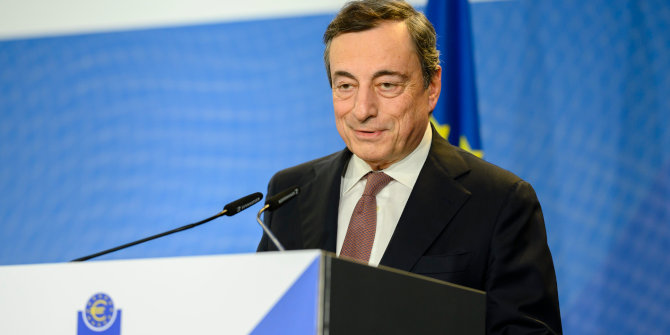
 Postfunctionalism and liberal intergovernmentalism are considered to be two of the ‘grand theories’ of European integration. In a recent article, Andrew Moravcsik, who developed the liberal intergovernmentalist model in the 1990s, has critiqued postfunctionalism, arguing that the politicisation of European integration has little effect on policy outcomes. Liesbet Hooghe and Gary Marks write that the rise of radical nationalism has had a marked impact on the European Union. Whereas liberal intergovernmentalism has little to say about the politicisation of European integration, postfunctionalism seeks to come to grips with the sources of identity, the conditions under which identity and functional pressures are mobilised, and their effects on European governance.
Postfunctionalism and liberal intergovernmentalism are considered to be two of the ‘grand theories’ of European integration. In a recent article, Andrew Moravcsik, who developed the liberal intergovernmentalist model in the 1990s, has critiqued postfunctionalism, arguing that the politicisation of European integration has little effect on policy outcomes. Liesbet Hooghe and Gary Marks write that the rise of radical nationalism has had a marked impact on the European Union. Whereas liberal intergovernmentalism has little to say about the politicisation of European integration, postfunctionalism seeks to come to grips with the sources of identity, the conditions under which identity and functional pressures are mobilised, and their effects on European governance.
The debate between postfunctionalism and liberal intergovernmental engages two basic questions: What are the causal underpinnings of international integration and how can one assess their relative validity.
On the first question, postfunctionalism and liberal intergovernmentalism agree and disagree. They share the (neo)functionalist premise that institutionalised cooperation among states is an effort to solve transnational problems. However, postfunctionalism argues that this is countered by the desire for self-rule on the part of those who conceive their national identity in conflict with supranational authority. Drawing on the comparative analysis of public opinion, voting, and political parties, postfunctionalism theorises the incidence of exclusive identity at the individual level, the conditions under which exclusive identity is politicised in party competition, and the resulting structure of political conflict. Liberal intergovernmentalism theorises European integration as a process of inter-state bargaining in which governments are chiefly motivated by economic preferences.
A recent article by Andrew Moravcsik critiques postfunctionalism along two lines. First, it downplays phenomena not subject to the economic logic of liberal intergovernmentalism. Second, it inflates liberal intergovernmentalism to encompass national identity and mass politics.
Moravcsik’s main line of argument is that popular opposition to Europe has ‘little effect’ because ‘populists have rarely been successful in recent general elections, referendums and European elections, and in exceptional cases of success, they soon moderate general opposition to the EU’. He claims that nationalism is symbolism without substance. Populist nationalism elicits only ‘rhetorical lip-service’ from governments. It amounts to ‘organized hypocrisy,’ a ‘kabuki theatre’. And, in any case, ‘[t]he potential salience of migration is not a recent development: majorities in nearly all OECD countries have opposed migration for decades’ (pp. 1662-63).
We disagree with both statements. The political salience of immigration has increased significantly over the past decade and, as postfunctionalism theorises, this has reinforced opposition to Europe. Radical ‘TAN parties’ (parties on the “Traditional, Authoritarian, Nationalism” end of the spectrum) have been pivotal in mobilising a transnational cleavage arising from the perforation of national states by immigration, integration, and trade. This phenomenon can be probed systematically. The Chapel Hill Expert Survey tracks the positioning of political parties on Europe and a range of issues over the past two decades. This has allowed scholars, including us, to investigate how political parties connect Europe to immigration across countries and over time. Moravcsik’s The Choice for Europe, which developed the theory of liberal intergovernmentalism, virtually ignores public opinion and party competition, and it has almost nothing to say about immigration.
Postfunctionalism theorises the conditions under which national identity is mobilised to shape jurisdictional reform. Brexit is an example of this in a high barrier party system where a new cleavage produces severe party divisions and high-voltage conflict. Postfunctionalism provides a sharp line of sight into the sources of the conflict, the decision to hold a referendum, the psephology of support and opposition, and the course of the debate in which Remainers appeal to the functional benefits of integration and Leavers oppose foreign rule and immigration.
Moravcsik claims that Brexit is merely symbolic politics. ‘LI [liberal intergovernmentalism] sees only two viable options: to reverse course and renegotiate Britain’s position within the EU, or to engage in “organized hypocrisy,” pulling out formally and rhetorically, while pressing to retain substantive policies as close to the status quo as possible … [E]ither way, functional policy changes little’ (p. 1664). The belief that ‘a political system will rebalance toward what its interests’ are appears to us Panglossian.
In the new rendition of liberal intergovernmentalism, the theory is stretched far beyond its former frame. To respond to the criticism that government preferences depend on much more than the producer groups that were the focus of The Choice for Europe, Moravcsik asserts that this was never his intention. But The Choice for Europe’s treatment of ‘nonproducers’ is simplistic. Their political influence is conceived as a function of a country’s per capita income. The effect of nonproducers is limited to regulation of particular policies, such as health and safety (pp. 36, 40).
Moravcsik’s recent article retreats from The Choice for Europe’s core claim that commercial preferences explain European integration, and understands LI as encompassing all rational influences on policy making ‘starting from the LI premise that “the primary interest of governments is to maintain themselves in office”’ (p. 1652). However, to explain how governments maintain themselves in office requires that one analyse issue linkage, partisan competition, public opinion, and elections – precisely the phenomena that The Choice for Europe excludes on grounds of simplicity.
Moravcsik wishes to contrast LI’s analysis of rational self-interest to the purportedly irrational politics of postfunctionalism. However, the forces theorised in postfunctionalism, including ideology, identity, the desire for self-rule, are no less rational or irrational than the pursuit of material self-interest. Rationality refers to the relation between means and ends, not the desirability of the ends. Political parties are rational in responding to exogenous change but have sunk costs that constrain their flexibility.
Postfunctionalism posits that identity as well as economic interest underlies preferences over European integration, and articulates expectations about their causal effects: ‘Identity is causally important to the extent that an issue has (a) opaque economic implications and (b) transparent communal implications that are (c) debated in public forums by (d) mass organizations rather than specialized interest groups’ (p. 13).
LI now covers all social groups: ‘[T]he most important determinant of international cooperation is the pattern of potential transnational co-operation and competition among societal actors’ (p. 1651). LI ‘encompasses a far broader range of phenomena than is often believed, including non-economic concerns, public opinion, partisan politics, the role of smaller states, informal and evolutionary processes and unintended consequences’ (p. 1650 – our italics).
These inflated claims are, in our opinion, regressive. They retreat from The Choice for Europe which asserts that treaties are negotiated by ‘national leaders who consistently [pursue] economic interests—primarily the commercial interests of powerful economic producers and secondarily the macroeconomic preferences of ruling governmental coalitions’. These claims are at least contestable.1 However, artificially stretching liberal intergovernmentalism widens the scope for ad hoc adjustment to cover every contingency.
1. A replication of the sources in The Choice for Europe available on our websites confirms Lieshout et al. (2004) in finding a consistent pattern of bias in interpretation and bias in omission.
Please read our comments policy before commenting.
Note: This article is based on the authors’ recent paper in the Journal of European Public Policy. The article gives the views of the authors, not the position of EUROPP – European Politics and Policy or the London School of Economics. Featured image credit: © European Union 2018 – European Parliament (CC BY-NC-ND 4.0)
_________________________________
 Liesbet Hooghe – UNC-Chapel Hill / EUI
Liesbet Hooghe – UNC-Chapel Hill / EUI
Liesbet Hooghe is the W.R Kenan Distinguished Professor of Political Science at the University of North Carolina at Chapel Hill and Robert Schuman Fellow at the EUI, Florence.
–
 Gary Marks – UNC-Chapel Hill
Gary Marks – UNC-Chapel Hill
Gary Marks is Burton Craige Distinguished Professor of Political Science at the University of North Carolina at Chapel Hill and Robert Schuman Fellow at the EUI, Florence.





Neofunctionalism and intergovernmentalism are the grand theories of European integration. This is just a spat between Hooghe and Marks who came up with postfunctionalism in 2008 and Moravscik who developed liberal intergovernmentalism in the 90s. If they were grand theories it would be at the stage where other academics were picking up the case for either of the two camps and not the original inventors of the theories still arguing it out.